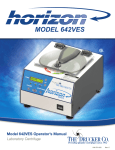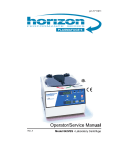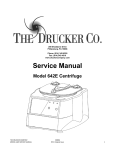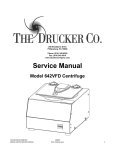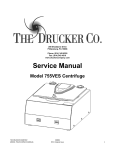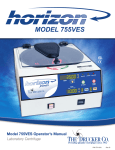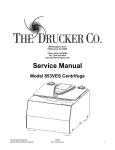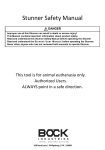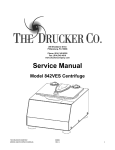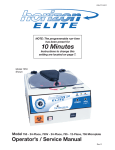Download Operator`s Manual - Drucker Diagnostics
Transcript
P/N 7711014 Replacement Parts: Part No. 7724177 7751068 7735049 7729009 7717046 7751043 7760002 7714101 7714103 7712316 7724071 7732018 7713030 7786048 Description Rubber Foot Switch, lid safety Motor, 1/30 H.P., 115 V.A.C. permanent split capacitor Capacitor, 5uF, 250V A.C. Electronic timing and locking board, w/display Circuit Breaker Power cord Pawl, latch, lid Knob, latch, lid Lid Hinge, friction Seal, lid gasket 2-Place 100mm Tube Carrier Horizontal Rotor Available Accessories: 1” Tube cushion p/n 1525 0.25” Tube cushion p/n 9150 WARRANTY: The Drucker Company warranties that this centrifuge is free from defects in workmanship and parts for 2 years. Made in the USA by Operator’s Manual Rev. B 200 Shadylane Drive • Philipsburg, PA 16866 Phone: 814-342-6205 or 814-692-7661 • Fax: 814-692-7662 • www.druckercompany.com Model 653ES • Laboratory Centrifuge Table of Contents Model Description Supplied Equipment Features Specifications Setup Location and Procedure Front Panel Controls Operation Rotor Removal and Installation Programming Functions Tube Holder Configurations Care and Maintenance Troubleshooting Safety, Emergency Lid Removal Calibration and Ground Testing Replacement Parts Available Accessories pg. 2 pg. 2 pg. 3 pg. 3 pg. 4 pg. 5 pg. 6 pg. 7 pg. 7 pg. 7,8 pg. 9 pg. 10 pg. 11 pg. 11 pg. 12 pg. 12 WARNING: Care should be taken when handling substances that are known to be toxic, radioactive or contaminated with pathogenic microorganisms when using this centrifuge for the safety of both the operator and service personnel. When Risk Group II materials are used, (as identified in the World Health Organization “Laboratory Bio–Safety Manual”), a Bio–Seal should be employed. More than one level of protection must be provided in the case of materials of a higher group. The use of flammable or explosive materials as well as those materials which chemically react vigorously is prohibited. Model Description: The Horizon Easy-Spin 12, model 653ES, is a continuous-duty, electronically-controlled horizontal centrifuge with a lid safety interlock system. The unit is controlled through a push-button interface with a digital time display for precise spin times and ease of use. Samples can be safely viewed through the transparent lid. Entry into the machine is restricted during operation by the safety interlock system. Supplied Equipment*: The following items come standard with each Horizon centrifuge: 1. One (1) horizontal rotor p/n 7786048 2. Operator’s manual 3. Six (6) 2-Place 100mm tube carriers p/n 7713030 1. Operator’s Manual 2. 3. * x6 Safety: The Horizon models 653ES complies with all requirements of UL standard 3101–2–20. Horizon Lid Safety Switch: The Horizon lid is secured to the top of the cabinet by a latching knob and pawl system. When the knob is rotated clockwise, the pawl grips the underside of the cabinet opening and prevents the lid from opening. A mechanical stop positions the pawl and prevents it from rotating completely. When rotated to the stop position, the pawl makes contact with a micro–switch mounted underneath the cabinet top. The lid safety switch prevents the centrifuge from operating while the lid is open. An indicator light on the front of the machine will light up when the lid has been latched properly. Horizon Lid Safety Interlock System: In addition to the Lid Safety Switch, the Horizon has a true “0 RPM” lid locking system. The lid safety interlock system keeps the lid locked at all times, (even during power failure), and requires that the rotor be at rest in order to unlock the lid. The centrifuge will not allow entry into the rotor chamber unless the centrifuge has power and the rotor is stopped. To open the lid, make sure that the centrifuge is plugged in and, with the rotor stopped, press the ‘OPEN / EMERGENCY STOP’ button. Note: After the centrifuge has started spinning, it may be possible to rotate the lid knob enough to cause the pawl to lose contact with the lid safety switch. If this happens, the centrifuge motor may lose power, but the lid will still remain locked. If the knob is accidentally moved and this situation should occur, rotate the knob fully clockwise to its stop position and the centrifuge will resume operation. Circuit Breaker: The Horizon is protected with a 4 Amp circuit breaker located at the rear of the machine mounted to the base. Any electrical short circuit will cause the breaker to cut power to the machine. Emergency Lid Removal: In the event of power failure, it may be impossible to unlock the lid by conventional means. In this case, the lid must be removed to gain entry into the rotor chamber and remove samples. To remove the lid, first take out the four (4) screws holding the hinge assembly to the cabinet. Slide the lid to the right or left until it is clear to remove it. The centrifuge must be serviced before it can be safely used again. Contact The Drucker Company for further assistance. Remove these screws on Calibration and Earth Ground Testing: It is recommended that the top speed, ground continuity and line leakage be tested every two years for continued safe operation. Contact The Drucker Company for further information or testing availability. The rotor and rotor accessories are rated for a rotation frequency of 4,000 RPM. Page 2 both hinges Page 11 NOTE: The latch must be turned completely clockwise to its stop position in order for the centrifuge to operate. Troubleshooting: 1. 2. 3. 4. 5. Problem: The rotor does not spin freely. Solutions: – Make sure nothing has fallen into the rotor chamber. – If there is nothing obstructing the rotor, contact The Drucker Company for further assistance. Problem: Excessive noise when the machine is running. Solutions: – Check to see that the load is balanced. – Make sure that nothing has fallen into the rotor chamber. – Make sure that the nut in the center of the rotor is tight. – Have a technician test the motor and replace it if necessary. Problem: The centrifuge does not run. Solutions: – Check the electrical outlet. – Make sure the lid latch is turned completely clockwise to its stop position. When the lid is closed properly, the latch light on the control panel will illuminate. – Check the circuit breaker switch at the bottom left of the machine. If the switch is white, the breaker has tripped. Contact The Drucker Company for further assistance. – The printed circuit board may be damaged. Have a technician test and replace the circuit board if necessary. Problem: The latch light does not come on when the lid is closed Solutions: – Make sure that the unit has power. – Make sure the lid latch is turned completely clockwise to its stop position. The latch makes contact with a switch underneath the front top of the cabinet. If this switch is not activated, the light will not turn on and the machine will not run. Problem: The machine does not unlock after a run has completed or will not unlock when the OPEN / EMERGENCY STOP button is pressed. Solutions: The lid can only be unlocked when the rotor is at rest. The lid is unlocked when the red UNLOCKED indicator light is illuminated. – The lid should remained locked until the rotor has nearly come to a complete stop and then unlock for 60 seconds. If additional unlock time is needed, press the ’OPEN / EMERGENCY STOP’ button with the machine plugged in and the rotor stopped. If the lid remains locked after this and will not unlock, the electronics may have been damaged. Contact The Drucker Company for assistance. To access the rotor chamber, follow the procedure on page 11, “Emergency Lid Removal”. Features: • Swing–out horizontal rotor design (patent-pending), incorporating a unique test tube holder that produces horizontally separated samples while requiring no additional parts • Digital time display for easy time setting and verification • Cool–Flow air flow design that prevents overheating of samples • Heavy gauge steel construction for safety and durability • Lid safety switch that prevents the centrifuge from operating unless the lid is closed and latched • Removable rotor for easy cleaning • Locking lid that allows entry into the centrifuge only after the rotor has completely stopped • Brushless permanent split capacitor AC motor • Clear lid for safe observation of samples and optical calibration of speed • Electonic braking for reduced deceleration time • Push-button operation • Indicator lights: ‘RUN’ green –lights when power is applied to the motor ‘LATCH’ yellow –lights when the lid is closed and latched ‘UNLOCKED’ red –lights when the lock system is deactivated Specifications: General Specifications for the Horizon Centrifuge Nominal Speed: Nominal RCF: Maximum capacity: Overall Dimensions (H x W x D): Centrifuge Motor: Nominal Acceleration Time: Protection Breaker: Timer: Current Requirement: Voltage Requirement: Frequency: Weight: Any use other than those specified by the Manufacturer is explicitly prohibited. * Maximum sample density is 1.15 grams / mL, (water density = 1.0 grams / mL) For servicing information or additional technical support, contact The Drucker Company at 814-342-6205 or 814-692-7661. Page 10 3,150 (+/- 150) RPM 1500 (+/- 100) xg 120 mL (12 x 10 mL)* 9.0 in. x 12.5 in. x 15 in. 1/30 HP, p.s.c. motor 60 seconds 4 Amp. re–settable electronic, 1 to 99 minutes +/– 1% 1.46 Amps 115 (+/- 10) Volts 60 Hz 18.5 lbs. Page 3 Setup Location: 1. Unpack the centrifuge and verify that all of the supplied equipment is present. 2. Choose a setup location which meets the following criteria: a) A bench top clearance height of 20” is required in order to open the lid. b) The clearance envelope is the space around the centrifuge which is required for safety. Choose a setup location which will allow for a clearance envelope of at least 27” x 27”, (with the centrifuge at the center). No person or hazardous material shall be permitted in the clearance envelope during operation. The operator time within the envelope shall be limited to the time necessary for loading, unloading and centrifuge operation only. c) Proper ventilation is necessary to prevent the overheating of samples as well as premature failure of the centrifuge. Choose an area which will allow unencumbered air flow. d) The centrifuge is designed to secure to the operating surface by four suction feet. No adjustment is necessary for leveling the centrifuge, however, the surface should be flat and level. e) Be sure the outlet is always within reach as the line cord is the means of emergency disconnection! Initial Setup Procedure: If any problems are found during the initial setup procedure, refer to the troubleshooting section on page 10. For further assistance, contact The Drucker Company at 814-342-6205 or 814-342-6205. 1. 2. 3. 4. 5. 6. 7. 8. 9. 10. Plug the centrifuge in to an approved electrical outlet. For electrical safety, the unit must always be properly grounded. The centrifuge will run through an initial warm-up process. During this time, a countdown and the word “HOLd” will appear on the display. During this time, the centrifuge will not accept any button presses. Once the centrifuge unlocks, continue to step 2. For safety purposes, the locking system is activated unless instructed by the operator after an end-of-run. To deactivate the system, (in order to insert or retrieve samples), press the ‘OPEN / EMERGENCY STOP’ button on the control panel while the rotor is stopped. The ‘UNLOCKED’ indicator light should illuminate. If it does not, refer to page 10 on troubleshooting. The lid will be unlocked for 15 seconds after pushing the ‘OPEN / EMERGENCY STOP’ button. Turn the latch counterclockwise and open the lid. Spin the rotor by hand; check for free and level rotation. If the rotor does not spin freely, refer to page 10 on troubleshooting. Place the six test tube carriers inside the rotor and verify that they are seated properly. Close the lid. Rotate the lid knob clockwise to its complete stop position. The ’LATCH’ indicator light should be illuminated. If it is not, make sure that the lid is latched properly. The centrifuge will not run unless the lid is latched and that the ’LATCH’ light is on. Adjust the preset time (if desired) and then press the START button to begin the test run. The ‘RUN’ indicator light will illuminate and the timer will begin to count down. The test tube carriers will slide up into the horizontal position and the unit will accelerate to full speed. Listen to the sound of the centrifuge. A smooth whirring sound should be heard. If there are any loud or unusual sounds, stop the centrifuge by pushing the ’OPEN / EMERGENCY STOP’ button immediately and refer to page 10 on troubleshooting. Page 4 (cont.) Care and Preventative Maintenance: With proper care and maintenance your Horizon centrifuge will provide years of laboratory service. For proper care, the following steps should be taken: 1. Provide Adequate Ventilation: For cooling purposes, the Horizon draws in ambient air through the air intake cover on the top of the lid and exhausts this air in the rear of the base. The centrifuge should be placed on a hard smooth surface for good air circulation. 2. Always Spin Balanced Loads: Make certain that you are always spinning a balanced load. The Horizon has a unique counter balanced motor mounting design which, along with it’s rubber suction feet, produces excellent vibration dampening. However, out–of–balance loads may break glass test tubes and may produce unsatisfactory separation results. Proper load balancing will improve sample separation and extend the life of the centrifuge. Refer to page 6 on balanced loads for additional information on balancing the load. 3. Keep the Tube Holders Clean: NOTE: Always follow the safety guidelines of your laboratory to properly clean up and/or dispose of materials in the event that a substance known to be potentially toxic, radioactive or contaminated with a pathogenetic microorganism is spilt in or on the centrifuge. Small glass fragments left in the tube carrier after a tube breakage may adhere to the next test tube inserted in that carrier. When this tube is handled, these fragments may puncture protective gloves and lacerate the operator’s fingers or hand. Remaining fragments may provide stress points on subsequent tubes and result in additional breakage. If a tube breakage occurs, carefully remove the tube carrier. Properly dispose of the sample and tube fragments and thoroughly clean both the inside and outside of the tube carrier. Insert a new tube cushion (if necessary) and replace the tube carrier in the rotor. 4. Motor and Electrical Maintenance: The Horizon uses a brushless permanent split capacitor AC motor. It should not need servicing for the life of the centrifuge. The electrical components are selected for high reliability and should not need service. 5. Keep the Rotor Chamber Clean: Every six months, or whenever there is a tube breakage, (refer to the note in #3), it may be necessary to remove the rotor and clean the rotor chamber. Follow the instructions on page 7 to remove and reinstall the rotor. The rotor chamber, rotor and accessories shall be thoroughly cleaned using either isopropyl alcohol, soap and water, or bleach. The use of Fully/ Partially Halogenated Hydrocarbons, Ketones, Esters and all other chemicals not prescribed by the manufacturer may cause damage to the rotor and tube holders and shall not be used. CAUTION: Once the lid has been opened, unplug the line cord from the electrical outlet to eliminate the risk of electric shock during cleaning. Apply cleaning solutions with a towel or cloth. Do not submerge the centrifuge in water or other cleaning solutions as this will cause damage and void your warranty! 6. Tube Carrier Replacement: It is recommended that the tube carriers be replaced after 24 months of use. Page 9 Tube Carrier Configurations: The horizontal rotor shipped with your Horizon Centrifuge is capable of spinning tubes up to 16mm x 100mm. Use the following illustration to determine if you should use a tube cushion. Configuration A (100 mm tubes): Use the tube holder as is with no additional tube cushions. Configuration B (75mm tubes): Place a 1” tube cushion in the bottom of each of the tube locations in the tube holder as shown in the picture to the right. (Continued) 11. While the machine is running, try to turn the latch counterclockwise. Power may be cut to the motor but you should be unable to fully turn the latch. If it is possible to turn the latch and open the lid while the unit is running, contact The Drucker Company for assistance. Close and latch the lid. 12. Push the ‘OPEN / EMERGENCY STOP’ button. The ‘RUN’ indicator light should go out and the motor should slow to a stop. 13. The lid should remain locked until the rotor has nearly stopped. If the machine unlocks prematurely, contact The Drucker Company for assistance. Once the rotor has stopped, the interlock system will b come disengaged for sixty (60) seconds. The ‘UNLOCKED’ indicator light will illuminate during this time. 14. To gain entry into the centrifuge after this period has ended, simply press the ‘OPEN / EMERGENCY STOP’ button. The lid will unlock for fifteen (15) additional seconds. After the centrifuge has passed this procedure it is ready for operation. Control Panel: A. ‘TIME ‘TIME SET / UP/DOWN’ REMAINING’ Buttons Display ‘LATCH’ Indicator Light ‘UNLOCKED’ Indicator Light B. ‘RUN’ Indicator Light 1” Tube Cushions p/n 1525 (Configuration B) ‘START’ ‘BRAKE ‘BRAKE ‘OPEN / Button ON/OFF’ ON/OFF’ EMERGENCY Button Indicator STOP’ Light Button Indicator Lights: TIME DISPLAY: Shows the time set (idle) / shows time remaining during a run LATCH: Illuminates when the latch is properly closed UNLOCKED: Illuminates when the lid is unlocked RUN: Illuminates when the motor is running BRAKE: Illuminates when the brake feature is turned on / flashes when the motor is braking Buttons: START: STOP: BRAKE: TIME UP/DOWN: Page 8 See page 7 for additional functions Begins a run Ends a run / Unlocks the lid Toggles the brake status (AUTO / OFF) Set the time from 1 to 99 minutes Page 5 Operation: NOTE: Follow the initial setup procedure on page 4 before initial operation. 1. If the centrifuge is not plugged in, plug it into an approved 115 Volt A.C., 60 Hz. outlet. The centrifuge performs a warm-up process at power-up that takes approximately 50 seconds. 2. Push the ‘OPEN / EMERGENCY STOP’ button and then open the lid. 3. Insert cushions (if needed) into the tube carriers for the tube size you are using. Refer to ‘Tube Carrier Configurations’ (page 8) for assistance. 4. Place the test tube samples into the tube carriers. Be sure to follow the rules for balanced loads. 5. Close the lid and turn the lid knob clockwise to its complete stop position. The ’LATCH’ indicator light should turn on to indicate that the latch is closed properly. If the lid knob is not completely latched, the ‘LATCH’ indicator light will not turn on and the centrifuge will not operate! 6. Set the time desired buy using the up/down buttons next to the display. 7. Turn on the machine by pushing the ‘START’ button on the control panel. 8. The centrifuge should begin to spin. The ‘RUN’ indicator light should illuminate. IF A PROBLEM IS FOUND DURING A SPIN THAT REQUIRES THE CENTRIFUGE TO SHUT DOWN, PRESS THE ‘OPEN / EMERGENCY STOP’ BUTTON ! 9. After time has elapsed, the ‘RUN’ indicator light will extinguish and the rotor will slow to a complete stop. 10. The ‘UNLOCKED’ indicator light will illuminate and the locking mechanism will disengage allowing entry into the rotor chamber. If it does not, refer to page 10 on troubleshooting. 11. Turn the lid knob counterclockwise and open the lid. 12. Remove the samples. 13. If the machine re–locks before the samples are removed, press the ‘OPEN / EMERGENCY STOP’ button to unlock the lid for an additional fifteen (15) seconds. BALANCED LOADS Your centrifuge must contain a balanced load in order to work properly. Use the following rules when loading the rotor. Spinning balanced loads will extend the life of the machine and produce better results. 1. Opposing tube carriers must be identical and must contain the same cushions, or none at all. 2. Opposing tube carriers must be empty or loaded with equally weighted samples. 3. If an odd number of samples is to be spun, fill a tube with water to match the weight of the unpaired sample and place it across from this sample. Page 6 Before using any cleaning or decontamination methods except those recommended by the manufacturer, users should check with the manufacturer that the proposed method will not damage the equipment. The rotor chamber, rotor and accessories shall be thoroughly cleaned using either isopropyl alcohol, soap and water, or bleach. The use of Fully/Partially Halogenated Hydrocarbons, Ketones, Esters and all other chemicals not prescribed by the manufacturer may cause damage to the rotor and tube holders and shall not be used. Rotor Removal and Installation: To remove the rotor: 1. Unlock the centrifuge by pushing the ‘OPEN / EMERGENCY STOP’ button and unlatch and open the lid. CAUTION: Unplug the centrifuge from the electrical outlet at this time to eliminate the possibility of electrical shock or other injury. 2. Remove the test tube carriers. 3. Remove the knob in the center of the rotor by turning it counterclockwise, (a tool may be required). 4. The rotor is sitting on a cone-shaped adapter. Pull the rotor up and off of this adapter. To install the rotor: 1. Place the rotor back onto the cone-shaped adapter. You may need to turn the rotor slightly to line it up properly. 2. The rotor should slide onto the rotor cone freely. 3. Once a proper fit has been achieved, replace the rotor knob and turn it until it is hand-tight, (a tool may be required). 4. Replace the tube carriers and verify that they are seated properly. 5. It is recommended that the initial setup procedures be performed to ensure that the rotor has been installed correctly and that no damage has been done to the centrifuge during either the rotor installation or possible rotor chamber cleaning. See page 4 for this procedure. Programming Functions: END OF RUN INDICATOR: At the end of a cycle, the unit can be programmed to beep to inform the operator. While the centrifuge is running (the green RUN indicator light is on) press and hold the START until a beep is heard to toggle the current setting. One beep means that the indicator is disabled, two means it is enabled. DIGITAL CYCLE COUNTER: While the centrifuge is idle, open the lid. Press and hold the START button for approximately 5 seconds. The current cycle count of the unit will be shown on the display and will remain until the START button is released. Page 7








